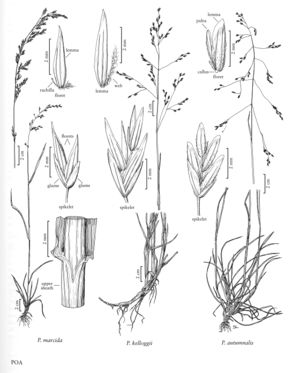Poa marcida
Plants perennial; not rhizomatous, not stoloniferous, sometimes shortly rhizomatous, loosely to densely tufted. Basal branching mainly pseudointravaginal. Culms 20-80 cm. Sheaths closed for at least 9/10 their length; ligules 0.5-2 mm, smooth, truncate; blades 1.5-5 mm wide, flat, lax. Panicles 6-22 cm, lax, narrowly lanceoloid, sparse; nodes with 1-3 branches; branches ascending, lax, angled, angles scabrous. Spikelets 3.5-7 mm laterally compressed; florets (1)2(4); rachilla internodes about 1 mm, smooth, glabrous. Glumes distinctly keeled, keels scabrous; lower glumes 1-veined; upper glumes shorter than or subequal to the lowest lemmas; calluses webbed, webs sparse; lemmas 3.2-5 mm, narrowly lanceolate, distinctly keeled, glabrous, acuminate; palea keels scabrous, sometimes sparsely so; anthers 0.5-1.2 mm. 2n = unknown.
Distribution
Oreg., Wash., B.C.
Discussion
Poa marcida is an uncommon endemic of breaks in rich, mesic, generally old growth forests of the Pacific coast, from Vancouver Island through the western foothills of the northern Cascade Mountains to central Oregon. It differs from P. saltuensis (p. 510) in its closed sheaths and attenuate lemmas.
Selected References
None.
